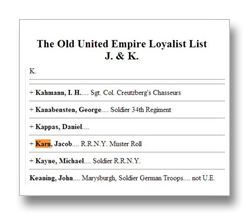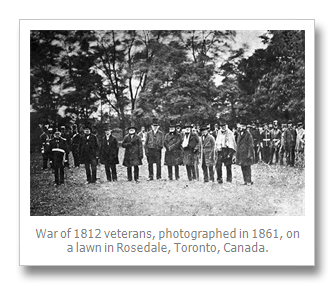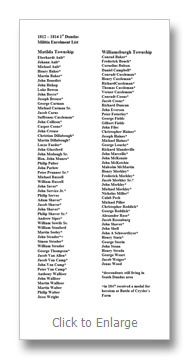It must have been an arduous journey for my 5th. great-grandfather, Jacob Karn travelling from the Palatinate region of the Rhine River to the Netherlands then to England, and through to the Delaware River region in the New World.
I have always been interested in finding my family history. In May 2014, I wrote, Finding my ancestor… and his Battle for Oswego for TI Life. It was the story of how I found Private Dorman DeWolfe, UE, who at 17 years old, in the spring of 1812, was recruited in Kingston, and fought in this unit throughout the conflict; he was present at the campaigns along the St. Lawrence and the Niagara frontier, survived, and was discharged in the spring of 1815.
Tracing the history of Jacob Karn (also spelled Carn), has been equally interesting.
I discovered his name appearing as a witness for a neighbour "on the Delaware," on Land Claims documents found in the Bureau of Archives. Dated 1788, these papers are a wealth of information as they name individuals, displaced by the American Revolution, who travelled north from the Hudson River region and Mohawk Valley area, through to the environs of the St. Lawrence River region, seeking similar geography, under the protection of the Crown, at the end of the conflict.
Jacob Carn and family, settled at the site of "Royal Township 5," in Matilda Township, Dundas County; near today’s villages of Iroquois and Morrisburg, on the St. Lawrence River. I was able to trace his enlistment as a member of the King's Royal Regiment of New York, on 1 Feb, 1780, as a member of the 1st Battalion, and in "Munro's Company, 1781-83.” “The Royal Yorkers," as noted on his "Petition for Land," dated at York 1797. He may have been garrisoned in the Montreal area, and possibly at Oswego, Carleton Island, and/or Cataraqui - "in the King's Works".

In fact records show that circa 1780, an advance party of the "Royal Yorkers" garrisoned in Kingston, constructed barracks amongst the ruins of Old Fort Frontenac, known as the former Tete du Pont Barracks. The site extends under four stone buildings, constructed during the 1820's. Only a fragment of the original fort can be seen today. Sections of the west and north limestone curtain walls are exposed on a traffic island at the intersection of Ontario Street and Place D'Armes (Heritage&Urban Design-City of Kingston).
Jacob Carns Sr. was a "United Empire Loyalist". His son, Jacob Carns, also has a petition for 200 acres of land signed the same date at York (Toronto). Another son, Christian Carns1 is also noted as having land in Matilda. The Carns family are interwoven with other "Loyalist" ancestors of mine through time, geography, and marriage.
I also discovered that the family fought in the War of 1812. A Jacob Carns is enlisted as a "flanker"2 in the 1st. Flank Co., Dundas Militia in the years 1812, 1813, and 1814.
The 1st Flank Company was an active unit in the conflict along the St. Lawrence corridor fighting at: Toussaint's Island - September 16 – 1812; Prescott - October 4, 1812; Salmon River - November 23, 1812; Ogdensburg - February 22, 1813 and finally at Crysler's Farm - November 11, 1813. The Company was also assembled for six months at Maria Town in 1812.
This is a "bonafide" document, with proof that my ancestor was enlisted in the Dundas Militia, in the War of 1812. |
Jacob Carns' brother Christian is listed in Pay Lists: 1812 - 1815, as a Private - 1st Regiment, Dundas Militia, 1813, under Captain John Crysler. I was fortunate to retrieve a copy of an archival military report entitled, "The Battle of Matilda - the morning of September 16, 1812.” The unsigned document lists an attack by "about 500 American Militia on Toussaint's Island against the Newfoundland Regiment, and the Dundas Militia, under Michael Ault. It also makes reference to meeting their old enemy - 'the rebels of 76', and reference to a cannon, being brought from Prescott, which had been captured from the French "at Chimney Island in 1760." The document states; "in a short time the people of Matilda and many from Williamsburgh assembled on the Presquile Island with Colonel Allan MacDonell commanding the Dundas Militia - Colonels William and Thomas Fraser present."


I also discovered Jacob Carns III, born circa 1808 and married to Catherine Hogeboom, daughter of John Hogeboom and Mary Cain - daughter of UEL Isaiah Cain, a veteran of the Seven Years' War and the American Revolution and (relict) Leah Adams, who settled near Caintown (north of Brockville). Jacob Carns is listed in the 1st Regiment Leeds Militia3 - 2nd Company 1828.
In 2011, I joined the group, "Honour our 1812 Heroes.” We are concerned Canadians dedicated to securing official recognition of the Canadian Military units which fought in the War of 1812. We also help preserve the legacy of those units by the awarding Battles Honours to units of the Canadian Forces that perpetuates them. Examples of units, include the 1st Regiment of Leeds Militia, 1812-1815; The Glengarry Light Infantry Fencibles, and the 1st Regiment Dundas Militia, 1812 - 1815.
I want to encourage others to become involved. It is always interesting to connect with natural and cultural heritage - with special focus upon the heritage landscape, topography, and history of the Upper St. Lawrence Corridor and the 1000 Islands.
By Arthur Pegg, UE
Arthur Pegg is a writer and historian, living in Blenheim Ontario, near Rondeau Provincial Park, on Lake Erie. He teaches history at the campuses of St. Clair College - Chatham and Windsor, Ontario. Arthur is a member of the Col. Edward Jessup Branch - United Empire Loyalists Association, and a member of the War of 1812 Society. He can be reached at arthur.pegg@sympatico.ca
Suggested Reading:
- The History and Master Roll of The King's Royal Regiment of New York, Revised Edition. Cruikshank & Watt
- The Incredible War of 1812, J. McKay Hitsman
- Field Of Glory: The Battle of Crysler's Farm, 1813. Donald E. Graves, 1999
- -loyalist.trails@uelac.org
|
1
The Story of Dundas, by J. Smith Carter
2
source: book - Soldiers of the King
3
source: Men of Upper Canada